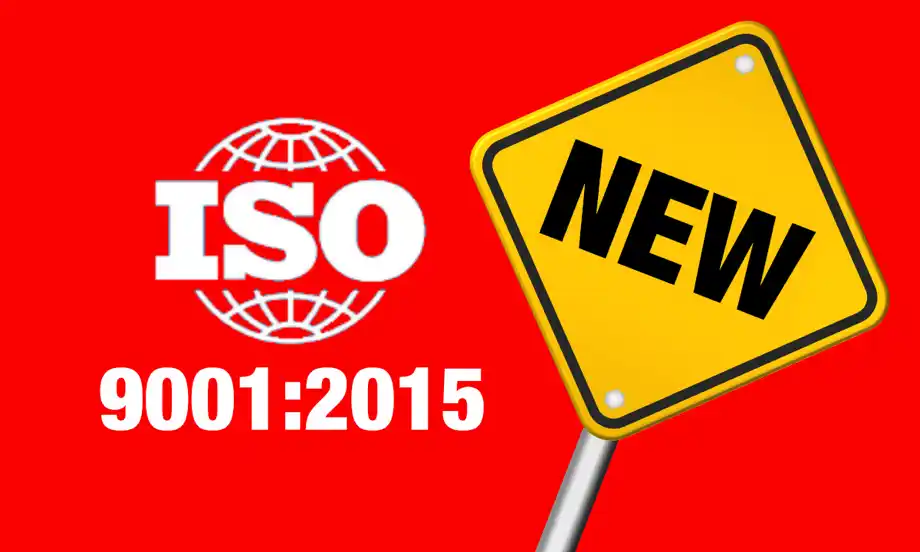ISO 9001:2015 - What's New?
7 November 2018
There is a new ISO 9001 standard. Why? Because ISO 9001 is revised by its publisher (the International Organization for Standardization "ISO") approximately every 7 - 9 years. The current version was published on September 23, 2015; it is called ISO 9001:2015 (the ":2015" indicates the year of revision). We'll explain what's new in the 2015 version.

Revisions
Each revision of the ISO 9001 standard may introduce new or modified requirements and/or a different structure of the standard; sometimes only the wording is updated for the sake of clarity. The new ISO standard (2015 version) includes moderate changes to requirements and vocabulary, and a completely new structure.
ISO 9001 has significantly changed in the past: the first revision in 1994, ISO 9001:1994, also included ISO 9002 and ISO 9003 (these were variations of ISO 9001 for different industries), the "big" revision in 2000 (ISO 9001:2000), and the minor revision in 2008 (ISO 9001:2008). All of these prior versions are obsolete and certifications are no longer valid. Certifications to ISO 9001:2008 expired in September 2018.
Transition Period
Once a new version of the standard is published, a three-year transition period starts during which both the old and new standards remain valid. During this period, companies are expected to upgrade their existing QMS – and their certificates – to the new ISO version.
With the publication of the 2015 revision on September 23, 2015, the 3-year transition period started during which the previous 2008 version remained valid. By September 2018, all ISO 9001:2008 certifications should have transitioned to ISO 9001:2015. Companies that missed the transition deadline lost their ISO 9001 certification.
What's New in the 2015 Version?
Here is a summary of the changes in the new ISO 9001:2015 standard compared to the ISO 2008 version:
New Structure
ISO 9001:2015 is based on a new high-level framework – Annex SL – that will be common to all ISO management systems standards. The purpose is to simplify the integration of ISO 9001 with other standards (for example, ISO 14001). The new framework leads to a new structure of the ISO 9001 standard. The new structure of ISO 9001:2015 requirements:
Section 4: Context of the organization
Section 5: Leadership
Section 6: Planning
Section 7: Support
Section 8: Operation
Section 9: Performance evaluation
Section 10: Improvement
Note: sections 1-3 remain introductory and explanatory sections (scope, normative references, terms and definitions).
It is important to note that the structure of the ISO 9001:2015 standard is intended to provide a coherent presentation of the ISO 9001 requirements. It is NOT intended to be a model for your company's ISO 9001 documentation. In other words, you may or may not use the new structure and numbering system for your procedures and related documentation.
New Wording
In order to facilitate better integration with other ISO standards, the new high-level framework also incorporates new wording. The new wording includes:
The term "products" has been replaced by "products and services" to make it clearer and easier for service providers
The terms "documentation", "documented procedures", "records", and "quality manual" have all been replaced by the term "documented information"
The term "work environment" has been replaced by the term "environment for the operation of processes"
The term "monitoring and measuring equipment" is now referred to as "monitoring and measuring resources"
The term "purchased product" has been replaced by the term "externally provided products and services" partially in order to make it clearer that services need to be considered as well
The term "supplier" is now called "external provider"
While people may argue if the new wording improves understanding or not, the good news is that you don't have to use the same wording. As with the structure, the new wording was introduced in order to create a common framework for all ISO management standards.
New Requirements
ISO 9001:2015 introduces a number of completely new requirements that have not been part of any previous version of ISO 9001. These new requirements can be found in the following sections:
Section 4.1 "Understanding the Organization and its Context"
Section 4.2 "Understanding the Needs and Expectations of Interested Parties"
Section 4.4 "Quality Management System and its Processes"
Section 5.1 "Leadership and Commitment"
Section 6.1 "Actions to address Risks and Opportunities"
Section 6.3 "Planning of Changes"
Section 7.1.6 "Organizational Knowledge"
The most important of the new requirements in ISO 9001:2015 is the focus on risk management in section 6.1. While previous versions had a section on preventive action, the new 2015 version expands upon preventive action to create a complete section on risk management. This new requirement will be of great value for many small businesses that had previously not properly managed the internal and external risks to their very existence.
Changes to 2008 Version Requirements
Besides introducing several completely new requirements, the 2015 ISO revision also introduces some modifications to existing requirements (i.e., requirements of the 2008 revision). You will need to upgrade your existing procedures, forms and flowcharts that cover the following topics:
Scope of the quality management system (as shown on your ISO 9001 certificate)
Control of Documents (section 4.2.3 in ISO 9001:2008)
Management Commitment (section 5.1 in ISO 9001:2008)
Customer Focus (section 5.2 in ISO 9001:2008)
Management Review (section 5.6 in ISO 9001:2008)
Human Resources (section 6.2 in ISO 9001:2008)
Customer Property (section 7.5.4 in ISO 9001:2008)
Corrective Action (section 8.5.2 in ISO 9001:2008)
Preventive Action (section 8.5.3 in ISO 9001:2008)
With the 2015 version of the standard, top management gets more involved in ISO 9001. To prevent misunderstandings right away, this DOES NOT mean that top management has to engage in any bureaucratic paperwork or operational issues; it DOES mean that top management uses ISO 9001 as a useful tool to manage the business. Areas that some top management may have paid insufficient attention to in the past must now be addressed by top management in order to be an ISO 9001 certified business; these areas include top management's understanding of its overall market and business environment, as well as its internal strengths and weaknesses.
A somewhat smaller upgrade is the increased focus on good communication within the company and with external parties, as well as the requirement for awareness (members of the company have to be aware of the consequences of their work or the failure of doing their work properly). Two new sections, 7.3 "Awareness" and 7.4 "Communication" are addressing those requirements.
Clarifications
Even more so than the 2008 version, the 2015 ISO version better clarifies existing requirements as well as the intent of existing requirements. For example, the requirements for quality objectives, measurement and change are more detailed.
It is important to realize that these are merely clarifications to existing requirements that organizations had wrongly applied or interpreted in the past. Our clients won't need to be concerned as we had correctly interpreted the ISO 9001:2008 requirements and their intent, and our materials have been reflecting this.
How Will ISO 9001:2015 Affect Me?
In general, ISO 9001:2015 will have a positive impact as it is clearer and better than the previous version. Companies with a cumbersome ISO 9001:2008 system will benefit as the 2015 version will help them get rid of bureaucracy and busywork. Our clients, on the other hand, who have always had an efficient and lean ISO 9001 system, will see fewer changes in operations and documentation.
If You Are Completely New to ISO 9001
If you are planning on getting ISO 9001 certified for the first time, you will benefit from the improved 2015 version right away. Our recommendation is that you start your ISO 9001 implementation as soon as possible. Don't delay enjoying the numerous benefits of ISO 9001. We offer excellent ISO 9001:2015 materials. Please take a look at the ISO 9001:2015 Certification Toolkit; it's a comprehensive ISO 9001 implementation kit (free consulting included so you won't get stuck).
If Your Company Missed the Transition Deadline
Many companies have missed the transition deadline of September 2018 and lost their ISO 9001:2008 certification. It's not the end of the world. But it's an indication that your quality management system isn't working well and, therefore, an opportunity for improvement.
You may want to discuss re-certification with your existing registrar or transfer your certification to another registrar (use our service to get free registrar quotes). The efforts needed to improve your ISO system depend on your situation. Contact us and let our experts assess your situation and recommend a solution.
Summary of What You Need to Know
ISO 9001:2015 was published on September 23, 2015 and superseded ISO 9001:2008 (which was published in November 2008).
Existing ISO 9001:2008 certifications lost their validity in September 2018.
Companies that had been certified to ISO 9001:2008 need to upgrade their ISO system and then apply for a new certification.
ISO 9001 will not be revised again until the year 2024 or later.
The 2015 revision brought some welcome upgrades in content and structure to the standard. The changes will particularly benefit organizations with an underperforming ISO system.
Companies that are planning on ISO 9001 certification should start as soon as possible.
Companies whose ISO 9001:2008 certification expired may contact us for a customized solution.
